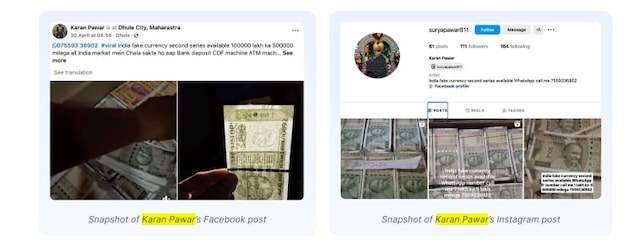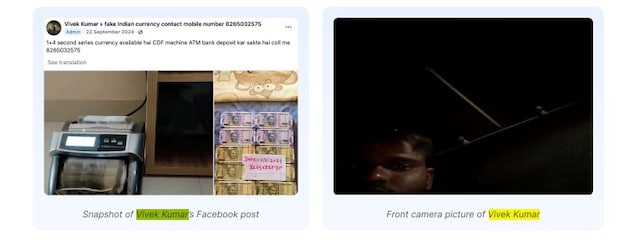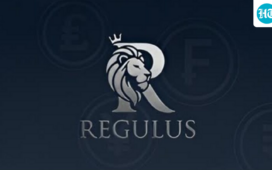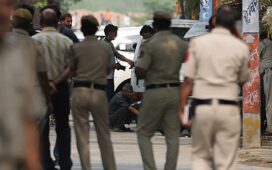Kharge questioned the role of regulatory bodies. “If fake notes can be sold on Instagram and other platforms, why aren’t your agencies monitoring this? What is @FinMinIndia’s Financial Intelligence Unit and the @RBI doing?”
Report uncovers ₹17.5 crore fake note network
The concern is underscored in a recent report by a Bengaluru-based cybersecurity and threat intelligence company, CloudSEK, that revealed a sprawling, organised counterfeit currency network operating across Facebook, Instagram, and YouTube. According to the report, counterfeit notes worth ₹17.5 crore were pushed into circulation in just six months.
CloudSEK’s threat intelligence team, STRIKE, identified over 4,500 social media posts, 750+ user accounts, and 410+ phone numbers promoting counterfeit Indian currency. Sellers flaunted bundles of fake ₹500 and ₹2,000 notes in videos, offering up to ₹5 lakh in fake currency for every ₹1 lakh in genuine money. “COD available. Delivery across India,” one video claims, with the seller’s number clearly visible.
The sellers claim their “A1 quality” notes can bypass ATMs, cash deposit machines, and counterfeit detectors, boasting features like watermarks and security threads.
The findings show that many sellers initiate transactions through WhatsApp or phone calls, offering live video calls and handwritten signs with phone numbers as “proof of legitimacy”. Some even use Meta Ads, exploiting hashtags like #fakecurrency and #A1note to avoid detection.
The report reveals how high-quality counterfeit notes are being produced using Adobe Photoshop, industrial-grade printers, and specially sourced paper embedded with green threads and watermarks. Photoshop (.PSD) templates are also shared to help others print fake notes at home.
Using OSINT and HUMINT techniques, the company traced key operators to Jamade village in Maharashtra’s Dhule district. Sellers identified include Vivek Kumar, Karan Pawar, and Nishant Chavare. In all, 350 active sellers were estimated to be part of the network.


CloudSEK conservatively estimates ₹17.5 crore in counterfeit notes circulated between December 2024 and June 2025, based on seller activity and minimum transactions. The actual figure may be significantly higher.
Experts call for immediate legal and enforcement action
In Maharashtra, the state government informed the Legislative Council on July 16 that 273 fake currency cases were registered in the last five-and-a-half years, leading to 566 arrests. Home Minister Devendra Fadnavis told the Council that Pune police confiscated fake notes worth ₹28.91 lakh on April 17 this year. Legislators Sanjay Khodke and Eknath Khadse also pressed for data on raids on fake note production units.
Prof Triveni Singh, Retd. IPS officer and chief mentor at Future Crime Research Foundation (FCRF), said, “The open sale of counterfeit currency on social media is not just financial fraud—it’s a direct attack on our economic integrity and national security. Such crimes erode public trust in the currency system and can be exploited by larger criminal or terror networks. Law enforcement must stay ahead by actively monitoring digital platforms, collaborating with cybersecurity experts, and launching targeted crackdowns before these operations grow beyond control.”
Advocate Prashant Mali, Bombay High Court lawyer and cyber and data protection expert, outlined the applicable legal framework. “It falls under Sections 176 to 179 of the Bharatiya Nyaya Sanhita (BNS), 2023, which deal with counterfeiting currency, and also under Section 66D of the IT Act, 2000, which pertains to online cheating,” he said.
Mali added that platforms like Meta could lose their safe harbour protections under Section 79 of the IT Act if they fail to act on reported illegal content. “As per Rule 3(1)(b) of the IT Rules, 2021, intermediaries are required to remove or disable access to unlawful material upon receiving actual knowledge,” he noted.
On law enforcement responsibilities, he said, “Authorities should invoke Section 69A of the IT Act to block URLs hosting such content. They must conduct digital forensic analysis, trace digital footprints, and register cases under relevant sections of the BNS and IT Act to enable swift prosecution.”
Undermining the economy, one reel at a time
CloudSEK warns that counterfeit notes in circulation can:
- Destabilise the economy
- Cause financial losses for individuals and businesses
- Fund criminal or terrorist operations
- Burden law enforcement and banks
- Erode trust in high-value currency
CloudSEK’s report paints a troubling picture of how counterfeit networks have moved from underground operations to public platforms, exploiting digital reach to run a parallel currency economy.
As the line between dark web and mainstream blurs, the need for proactive enforcement, platform accountability, and public vigilance has never been more urgent. What you see in your feed might not just be fake news. It could be fake currency too!





